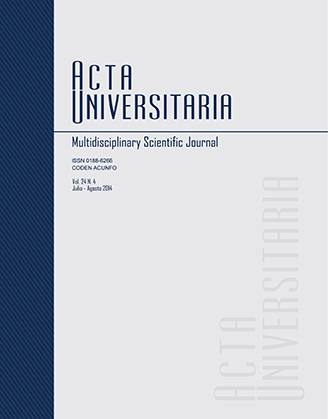Estudio tribológico de prensado en caliente de compuesto 2205 DSS reforzado por dispersión de óxido
Publicado 2014-08-21
Palabras clave
- Duplex stainless steel (DSS),
- partially sta¬bilized zirconia (PSZ),
- wear,
- coefficient of friction (COF),
- powder metallurgy (PM).
- Acero inoxidable dúplex (DSS),
- zirconia parcialmente estabilizada (PSZ),
- desgaste,
- coeficiente de fricción (COF),
- pulvimetalurgia (PM).
Cómo citar
Resumen
Este trabajo estudia la influencia de óxido cerámico en el comportamiento tribológico de materiales compuestos 2205 DSS de prensados calientes con una composición variable de porcentaje de partially stabilized zirconia (PSZ) y elementos de aleación; cromo (Cr) con niquel (Ni) desarrollado por ruta de pulvimetalurgia (PM). El experimento se realizó con un tribómetro de bola sobre disco, bajo los siguientes parámetros: Bola WC de 5 mm como contra cuerpo, carga deslizante de 15 N y 2 mm de distancia deslizante a temperatura ambiente en condiciones secas. Las huellas del desgaste de la superficie desgastada fueron examinados con Scanning Electron Microscope (SEM); JEOL JSM-7600F con Energy Dispersive X-ray Analysis (EDX) adjunto. Los resultados revelaron que una pequeña cantidad de PSZ puede amplificar la resistencia al desgaste del material compuesto. Los análisis EDX puntuales indicaron que había capas transferidas de tungsteno (W) en la superficie desgastada. Se utilizaron índices de coeficiente de fricción (COF) y Taber para evaluar la propiedad de desgaste de los materiales compuestos. Se encontró que la muestra con 0.5% PSZ, 0.81% de Cr y 0.19% de Ni tiene la mejor resistencia al desgaste.
Citas
- steels. Journal of the European Ceramic Society, 23(15),2813-2819.
Chawla, N. & Chawla, K. K. (2006). Metal matrix composites. New York: Springer.
Chen, H., Li, Y. Y., Liu, Y. B. & Cao, X. J. (2007). Influence of chromium on microstructure
- and sintering properties of FeNiMoCu system prealloyed powders. Journal of Materials Processing Technology, 182, 462-468.
Datta, P. & Upadhyaya, G. S. (2001). Sintered duplex stainless steels from premixes
- of 316L and 434L powders. Materials Chemistry and Physics, 67(1-3),
- -242.
Daumann, B., Webber, J. A., Anlauf, H. & Nirschl, H. (2011). Discontinuous powder
- of nanoscale particles. Chemical Engineering Journal, 167(1), 377-387.
Dobrzanski, L. A., Brytan, Z., Grande, M. & Rosso, M. (2007). Properties of Duplex
- Stainless steels made by Powder Metallurgy. Archives of Materials Science
- and Engineering, 28(4), 217-223.
Glage, A., Weigelt, C., Räthel, J. & Biermann, H. (2014). Fatigue Behaviour of Hot
- Pressed Austenitic TWIP Steel and TWIP Steel/Mg-PSZ Composite Materials. International Journal of Fatigue, 65(2014), 9-17.
Hamid, Z. A., Moustafa, S. F., Morsy, F. A., Khalifa, N. A. A. & Mouez, F. A. (2011).
- Fabrication and characterization copper/diamond composites for heat sink application
- using powder metallurgy. Journal of Natural Science, 3(11), 936-942. London: INSPEC/IEEE.
- article/energy-crisis-drives-increased-interest-research-in-tribology-2008-05-30.
Liu, N. B., Lim, S. C., Lu, L., & Lai, M. O. (1994). Recent development in the
- fabrication of metal matrix-particulate composites using powder metallurgy
- techniques. Journal of Materials Science, 29(8), 1999-2007.
Martin, F., García, C., Blanco, Y. & Aparicio M. L. (2013). Tribocorrosion behaviour
- of Powder Metallurgy duplex stainless steel sintered in Nitrogen. Tribology
- International, 57, 76-85.
Ming, L., Zhangjian, Z., Pei, H., Lu, L., Yingli, X. & Changchun, G. (2010). Microstructure
- and mechanical property of 12Cr oxide dispersion strengthened ferritic steel
- for fusion application. Fussion Engineering and Design, 85(2010), 1573-1576.
Passerone, A., Muolo, M. L., Novakovic, R. & Passerone, D. (2007). Liquid matel/
- ceramic interactions in the (Cu, Ag, Au)/ZrB2 systems. Journal of European
- Ceramic Society, 27(2007), 3277-3285.
Rachman, C., Amit, S. & Claude, E. (2009). Densification of nanocrystalline Y2O3
- ceramic powder by spark plasma sintering. Journal of the Ceramic Society,
- (2009), 91-98.
Reddy, K. M., Mukhopadhyay, A. & Basu, B. (2010). Microstructure-mechanicaltribological
- property correlation of multistage spark plasma sintered tetragonal
- ZrO2. Journal of the European Ceramic Society, 30(2010), 3363-3375.
Sebo, P., Kavecky, S. & Stefanic, P. (1994). Wettability of Zirconia-coated carbon
- by aluminium. Journal of Materials Science Letters, 13(1994), 592-593.
Sulima, I., Klimczyk, P. & Hyjek, P. (2009). The influence of the sintering conditions
- on the properties of the stainless steel reinforced with TiB2 ceramics. Archives of Materials Science and Engineering, 39(2), 103-106.
Vardavoulias, M., Jueandin, M., Velasco, F. & Torralba, J. M. (1996). Dry sliding
- wear mechanism for P/M austenitic stainless steels and heir composites
- containing Al2O3 and Y2O3 particles. Tribology International, 29(6), 499-506.
Velasco, F., Martínez, M. A., Calabres, R., Bautista, A. & Abenojar, J. (2009). Friction
- of PM ferritic stainless steels at temperatures up to 300 ºC. Tribology
- International, 42(2009), 1199-205.
Wei, D., Dave, R. & Pfeffer, R. (2002). Mixing and characterization of nanosized
- powders: An assessment of different techniques. Journal of Nanoparticle
- Research, 4, 21-41.
Taber Abraser (Abrader) (n.d.). Recuperado de www.taberindustries.com/taberrotary-abraser
Younesi, M. & Bahrololoom, M. E. (2010). Optimization of wear resistance and
- toughness of hydroxyapatite nickel free stainless steel new bio-composites
- for using in total joint replacement. Materials and Design, 31(2010), 234-243.
Zhoungchun, C., Takenobu, T., Keisuke, I. & Tadasu, M. (2000). The influence of
- powder particle size on microstructural evolution of metal-ceramic composite. Scripta mater, 43(2000), 1103-1109.

